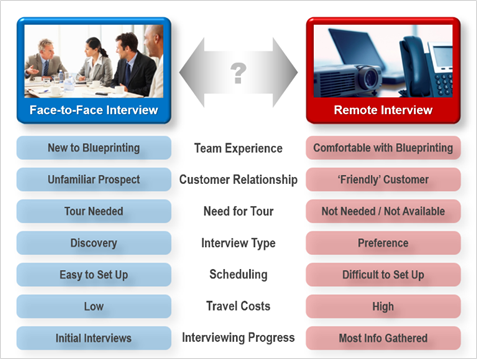When is it appropriate to conduct a web-conference interview?
Of courses, a face-to-face customer interview will always be the “gold standard.” Nothing beats direct human interaction for optimum rapport and understanding. But remote, web-conference interviews can be surprisingly effective… and very helpful when travel budgets and schedules are tight. As shown in this illustration, there are several factors to consider when deciding between a face-to-face interview and a remote one. Here are the most important considerations:

Team experience: If you are new to Blueprinting interviews, don’t start with remote interviews. The extra technical considerations will put too much stress on you. Better to get comfortable first by conducting several face-to-face interviews.
Customer relationship: If you already have a great relationship with the customer, you’ll find a remote interview quite easy to do. If not, it’s best to conduct your Discovery interview face-to-face. Perhaps then you could do your Preference interview with them later via web-conference.
Need for tour: Obviously, if you are keen to conduct a customer tour at their facility, you’ll need to schedule a face-to-face interview. Try to conduct the tour just before the interview… as this will provide great context for your interview discussion.
Interview type: Excellent remote sessions have been done for both Discovery and Preference interviews. But Preference interviews are the easier of the two to do remotely. The Preference interview is more linear, quantitative, and predictable… and it seems customers find it very easy to understand their role in these.
Scheduling: If you’re having difficulty getting the customer to commit to an interview time, consider asking for a web-conference. Some teams report customers are more willing to schedule a web-conference than a face-to-face meeting. Perhaps they feel they can more easily end the interview by saying, “Well, I’ve got to go to my next meeting now.” Also, it’s easier to include participants who are out of the office in these.
Travel costs: Travel costs for two or three interviewers can be quite high, especially if global interviews are needed. Consider having at least some members of your team stay home and join in via web-conference.
Interviewing progress: If you conduct 6-to-10 interviews, you’ll likely find you’re learning much more during the initial interviews than the later ones. Consider “wrapping up” your last few interviews via web-conference. This is especially true for Preference interviews. You might schedule lots of these via web-conference to boost your statistical confidence. For some of these, you could just ask for a 45-minute web-conference (and they’ll usually give you 60 minutes)… and only focus on gathering the 1-to-10 importance and satisfaction ratings.
For more on this topic, see e-Learning Module 20: Remote Interviews, at www.blueprintingcenter.com > e-Learning.
Keywords: remote interview, web-conference interview, video-conference interview, desktop sharing, face-to-face interview, interview in person, customer interview, visual link, audio link
